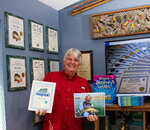
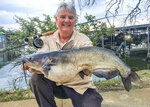
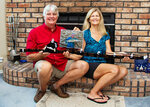
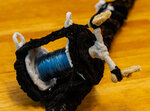
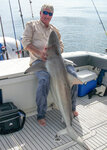
Believe it or not, Granbury’s Barry Osborn loves breaking Texas Parks and Wildlife Department (TPWD) fishing records so much that his appearing in the latest edition of “Ripley’s Believe it or Not” hardly seems to matter.
Then again, Osborn, 61, has been on a mission to promote Texas fishing opportunities, and he’s managed to nail down more than 100 official TPWD fishing records along the way.
“Texas has a really diverse fishery and a robust records program,” Osborn said. “I thought this would be a great way to demonstrate to people all the different species of fish we have here.”
Osborn came about his obsession honestly with an introduction to fishing at a young age by his grandfather. Now a couple of years short of retirement as a wildlife biologist (regulatory manager with the Corps of Engineers), he recently chalked up his 100th TPWD official state record certificate walleye he caught in Lake Meredith.
Osborn’s topping the century mark is made all the more remarkable when considering the earliest record the TPWD has listed for him came less than 12 years ago. Osborn currently has two other records in the certification process, which will bring his total to 102.
The TPWD has an extensive record program with weight records, length records, catch-and-release, and what some would consider a “niche” award category – and Osborn’s name appears everywhere across the TPWD website.
The only spot Osborn’s name isn’t mentioned is in freshwater bow fishing. But give him time, because he has a saltwater bow fishing record.
Appearing from a back room, Osborn’s wife of 42 years, Karen, emerges with two boxes of his record certificates. There are hundreds of documents, including TWPD state marks and world records from both of the world’s top fishing organizations (International Game Fish Association and the National Freshwater Fish Hall of Fame) that track anglers’ achievements.
Osborn also fishes close to home and owns 13 Lake Granbury records, categorized as “water-body records” under the TPWD program. Seven of those highlights are for fly-fishing. The biggest fish he’s pulled locally is a 36.26-inch 26.60-pound black buffalo. The lightest fish Osborn has landed out of Lake Granbury (on a fly) is a black crappie that weighed just six-tenths of a pound. That might sound a little light until you go and try and duplicate the feat yourself.
BELIEVE IT OR NOT
Osborn loves pursuing fish records so much, inclusion in the newest edition of “Ripley’s Believe it or Not” hardly seemed worth mentioning when he sat down for an interview with the Hood County News.
For most people, appearing in Ripley’s yearly hard-cover edition is a once-in-a-lifetime event. But being published for taking pipe cleaners and turning them into a working fishing rod and reel was just something Osborn’s coworkers “challenged” him to do after he made a miniature one as part of a work training project.
“I came up with a rod much smaller than the one I ended up making to get into Ripley’s,” Osborn said. “My coworkers kind of challenged me, so I decided I would try and make a working rod and reel.”
Armed with 1,500 pipe cleaners, Osborn devoted 50 hours of his free time to twisting, tying, bending, and manipulating the small fuzz-covered wires into a reel with working gears, and attaching it to a rod made of the same material.
The rod can cast bait along with lead weight, and Osborn retrieves it with the reel’s action.
That alone was good enough to earn the attention of Ripley’s, but the publication sparked yet another “prove-it moment” for the angler to nail down when it printed the statement, “he hoped to catch a record-breaking fish with his pipe-cleaner fishing pole.”
You don’t challenge Osborn unless you expect to see something amazing, and he has video proof that he’s hauled in a catch with his one-of-a-kind fishing rod. It’s worthy of noting Osborn may be the first person in the history of the world to catch a fish with such a rod and reel.
HIS “REEL” PASSION
While most of us would be buying up Granbury’s supply of “Ripley’s Believe it or Not,” Osborn remains glued to his passion for owning TWPD records, and he’s gone so far as to come up with his method he calls “PLNOR” — an acronym for his “pole and line, no reel” fishing technique.
The line starts wrapped around a simple spool, and after casting or lowering his bait/lure, Osborn retrieves the line in a manner like that of a fly fisherman, stripping it (ideally) into a bucket next to him.
The method may be primitive, but it has also landed Osborn at least 36 TPWD state records in the “other methods” category. It can be a bruising hobby, such as when he had a 102-pound world-record blacktip shark at the end of a 660-pound paracord, and was pinned against the boat’s wall.
“It is fantastic because when you are fighting the fish, you feel everything,” Osborn said. “It’s very challenging, and you are in control of it all.”
Things don’t always get that wild but when they do, anglers are on their own. That’s because any assistance with any device, including a limp line on the boat’s floor, is off-limits when it comes to recording an official record.
ANOTHER CHALLENGE
There are records for both weight and length under the state’s catch-and-release record category, and Osborn has made it another challenge to catch as many different fish species as possible. With retirement coming up in a couple of years, he’s also going to have more time to devote to setting more state records.
Osborn is dedicated, and he’s not always after big fish like the Lake Granbury record drum. His pursuit of the “gulf toadfish” (a fish as ugly as the name sounds) was a three-year quest, and landing the 1-pound, 3-ounce “monster” tops his memory of dragging in an 88-pound stingray.
The catch came at the end of a three-day excursion aimed at landing the record fish, and Osborn did a bit of a jig before measuring and weighing it for yet another spot in the IGFA all-tackle world record top angling spots.
“I was fishing in Port Aransas, and I have hundreds of dollars worth of fishing poles, but there I am holding a Zebco 888 and caught it,” Osborn said. “It was dusk, and we were ready to pull out and go home after three days of trying.”
It’s a small yet significant catch considering thousands of the fish have been caught and released as part of scientific studies. Osborn’s was the only gulf toadfish weighing more than a pound.
ELITE ANGLERS AWARD
Osborn has earned the Texas Elite Anglers award, and while Karen’s passion for fishing may not rival her husband’s, she has also earned the recognition. She also has state-record certificates and world-record plaques on the wall.
There are just 49 saltwater Texas Elite Anglers and fewer than 100 freshwater fishermen who have earned the honor, and the Osborns are on both of those lists.
PASSING IT ON
With his goal of introducing people to Texas’ fisheries, it only seems natural Osborn would eventually write a book to pass on his experience. Two years ago, “The Art of Fishing for Records” was published, and it is available via Amazon. It’s full of Osborn’s different methods for landing records. Included are tips on getting certification for a catch, and all of the required documentation to make everything official with the TPWD.
BACK TO THE RIPLEY THING
“Ripley’s Believe it or Not” revisited Osborn when he lived up to the challenge of landing a record fish, and he did it on a world scale at Lake Whitney. Osborn pulled in a 9-pound, 3-ounce black buffalo in a 30-minute battle using a 16-pound test line.
“I hooked the record black buffalo with a range cube as bait. Things were going pretty well until the fish pulled so hard it jammed the reel and hung up in the rocks,” Osborn said.” After some quick work to adjust the reel, I resumed reeling and freed the fish. I was then able to, very slowly, work it to the bank.”
To learn more about the TPWD fishing records and check out how Osborn’s name ranks among them, log online @ tpwd.texas.gov/fishboat/fish/programs/fishrecords/
Russell@hcnews.com | 817-573-7066 Ext. 231